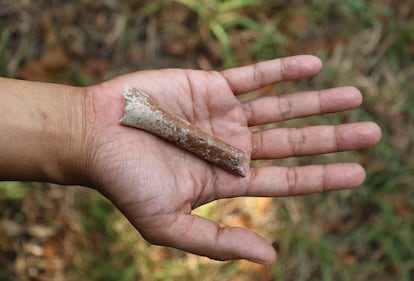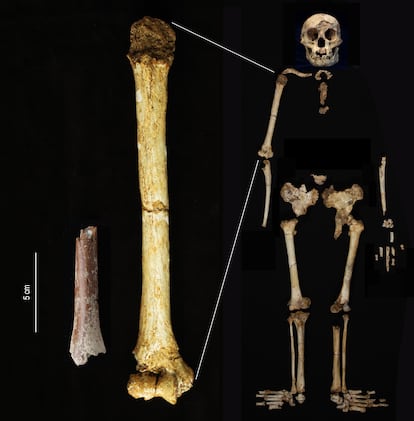Smallest arm bone ever found sheds light on the mystery of the Flores ‘hobbits’
Ancient humans who lived on an Indonesian island up to 50,000 years ago are believed to have descended from ‘Homo erectus,’ who became gradually smaller after arriving there a million years ago

A little over a million years ago, a group of Homo erectus who had colonized Java in Indonesia continued their journey eastwards through the Sunda archipelago, perhaps on natural rafts, until they reached Flores. There they became isolated and, through an evolutionary phenomenon that sometimes occurs on islands, began to shrink. Around 300,000 years after their arrival — a very short time by evolutionary standards — the descendants of Homo erectus, who were about the same height as modern humans, had become dwarfs, measuring one meters in height. They had small brains, but the same ability as their ancestors to make tools. These tiny human relatives, the smallest ever discovered, are the ancestors of Homo floresiensis, the so-called hobbits, whose 60,000-year-old fossils were found on Flores in 2004.
When the first bones were found in Liang Bua Cave, anthropologists were divided: some thought they had found a new species, while others believed they were tiny modern humans. Some anthropologists even believed that the remains may have belonged to a sick individual. The debate began to clear up in 2016, when a group of researchers led by Yosuke Kaifu from the National Science Museum in Tokyo reported on the discovery of more hobbit-like remains in Mata Menge, a cave 43 miles from Liang Bua. The researchers had found jaw fragments and six teeth from three individuals dating back 700,000 years. These individuals were even smaller than later hobbits, but it seemed clear that they were their ancestors. The similarity between the anatomy of the H. erectus suggested that all H. floresiensis, ancient and recent, came from members of this species of explorers, who gradually became smaller on the island.

On Tuesday, Kaifu’s team published new research in the journal Nature Communications that analyzes more bone fragments and strengthens the theory about the origin of the species. Along with more teeth, the researchers unearthed a fragment of a humerus. With this, the researchers estimated that the individual measured around 100 centimeters, six less than the height calculated for the later H. floresiensis. This would make them the smallest known ancestors of humans.
In addition, the researchers argue that the similarity between the teeth and jaw of the Mata Menge inhabitants and the remains of the H. erectus unearthed in Java means that the two groups were linked, and that the ancestors of the Flores humans were not older hominids, such as Homo habilis or Australopithecus, which have not been found outside of Africa.
Aida Gómez-Robles, a researcher at University College London, says that the new article “confirms what had already been published in 2016, that they were even smaller [than the most modern Flores humans] and that there is continuity with Homo erectus.” When asked about how the study estimated the height of the Mata Menge inhabitants, Gómez-Robles says that, with the humerus fossil, “the capacity for comparison is very limited” and the estimate “is very loose.” “But there is no question that it was a very small hominid and the molars, if compared with the known fossils, are the smallest by far,” she adds.
Although the origin of Homo floresiensis seems to be clear, there are still mysteries surrounding the species. For example, it is not known why they disappeared around 50,000 years ago. Until then, they had survived using tools not very different from those of their ancestors. For hundreds of thousands of years, they lived alongside giant storks, pygmy elephants and Komodo dragons, which disappear from the fossil record along with the hobbits. While the usual suspects are modern humans — who arrived in Australia 50,000 years ago and caused the extinction of many endemic species — no remains of modern humans have been on Flores until 11,000 years ago. That, however, does not mean they weren’t there. The answers remain in the subsoil of Indonesia, perhaps in the caves of Liang Bua or Mata Menge, where many remains are still to be excavated.
Sign up for our weekly newsletter to get more English-language news coverage from EL PAÍS USA Edition
Tu suscripción se está usando en otro dispositivo
¿Quieres añadir otro usuario a tu suscripción?
Si continúas leyendo en este dispositivo, no se podrá leer en el otro.
FlechaTu suscripción se está usando en otro dispositivo y solo puedes acceder a EL PAÍS desde un dispositivo a la vez.
Si quieres compartir tu cuenta, cambia tu suscripción a la modalidad Premium, así podrás añadir otro usuario. Cada uno accederá con su propia cuenta de email, lo que os permitirá personalizar vuestra experiencia en EL PAÍS.
¿Tienes una suscripción de empresa? Accede aquí para contratar más cuentas.
En el caso de no saber quién está usando tu cuenta, te recomendamos cambiar tu contraseña aquí.
Si decides continuar compartiendo tu cuenta, este mensaje se mostrará en tu dispositivo y en el de la otra persona que está usando tu cuenta de forma indefinida, afectando a tu experiencia de lectura. Puedes consultar aquí los términos y condiciones de la suscripción digital.
More information
Archived In
Últimas noticias
Most viewed
- Sinaloa Cartel war is taking its toll on Los Chapitos
- Oona Chaplin: ‘I told James Cameron that I was living in a treehouse and starting a permaculture project with a friend’
- Reinhard Genzel, Nobel laureate in physics: ‘One-minute videos will never give you the truth’
- Why the price of coffee has skyrocketed: from Brazilian plantations to specialty coffee houses
- Silver prices are going crazy: This is what’s fueling the rally










































